
Switzerland - trams, BLT Basellandtransport incl. WB Waldenburgerbahn
For a full scale picture, please click on the picture shown !
Trams of Basellandtransport BLT
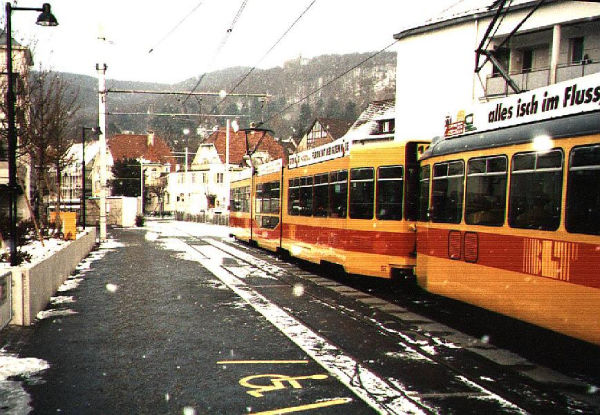
BLT or Basellandtransport is a company owned by the Baselland Kanton. It is the fusion product of Birseckbahn BEB (a line from
Basel up via the river Birs valley to Arlesheim, Baselland, and Dornach, in Kanton Solothurn), the Trambahngesellschaft Basel-Aesch,
which operated on the other side of the Birs valley from Basel to Aesch and the Birsigthalbahn, originally a real train line with
narrow gauge steam trains, designed to be built all the way from Basel via the Birsig river valley to Porrentruy, but which was never
built further than Rodersdorf. The combination of all this led to the construction of line 10 Dornach-Arlesheim-Basel-Flüh-Rodersdorf,
which is today one of Europe´s longest tram lines where one stop in the middle (the old Leymen station) actually is in France and also line 11,
Aesch-Basel-St. Louis border, another remarkably long line, with train-like fast service at the end close to Aesch. It takes more than
an hour for a tram to run through the line no. 10 and most of the line is clearly built for trains, not trams. The old stations look
pretty funny with today´s low-floor trams. In 2022 also the WB Waldenburgerbahn was integrated into BLT.
Basel is a city of only about 200 000 inhabitants but still an impressive tram network,
with two service companies BLT and BVB operating on the same network. Lines are long
and so are the trams.
BLT low-floor unit 265 on line 10 with an older 100-series carriage as a trailer. Picture is from
Arlesheim Dorf, Baselland, January 1999. Photo by Ilkka Siissalo.
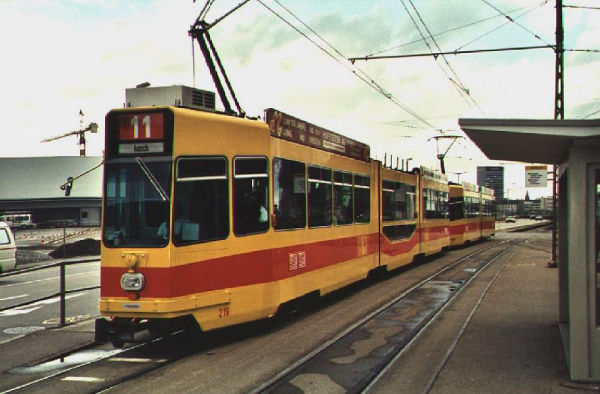
The tram lines in Basel are long, and so are the trams. Two companies, the Basel City BVB
and the Baselland BLT operate on the same network. The longest lines take well over an hour
to drive from end to end and the lines are extended a long way to the countryside. Here BLT
low floor articulated tram no. 219 with two joints together with a similar but non-low floor,
one joint wagon as a trailer at Wolfgottesacker in May 1999.
Photo by Ilkka Siissalo.
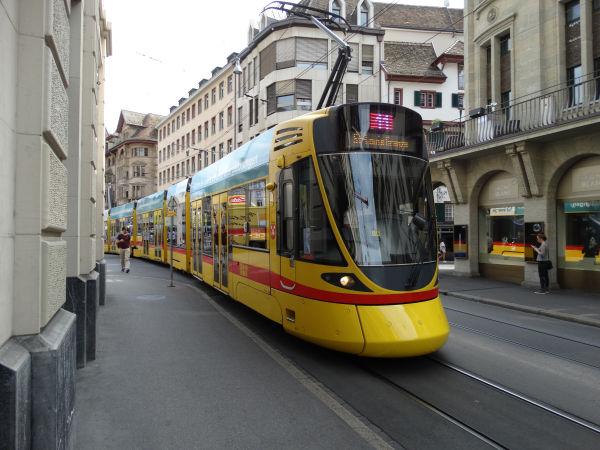
These are the new trams of BLT Basellandtransport. This Be 6/10 no.153 is of the type "Tango" built by
Stadler since 2008. It is 45 metres long and has place for 94 sitting and 182 standing passengers. 75% of the tram is
low-floor.
Picture from Marktgasse near Marktplatz in Basel 12.7.2019 by Ilkka Siissalo.
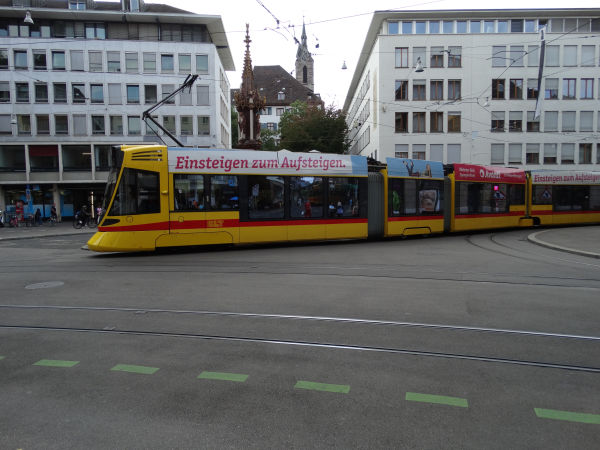
One of the Stadler Tango trams Be 6/10 no.183 negociating the S-shaped curves by the tramstop Schifflände in Basel.
Picture from Schifflände tramstop in Basel 12.7.2019 by Ilkka Siissalo.
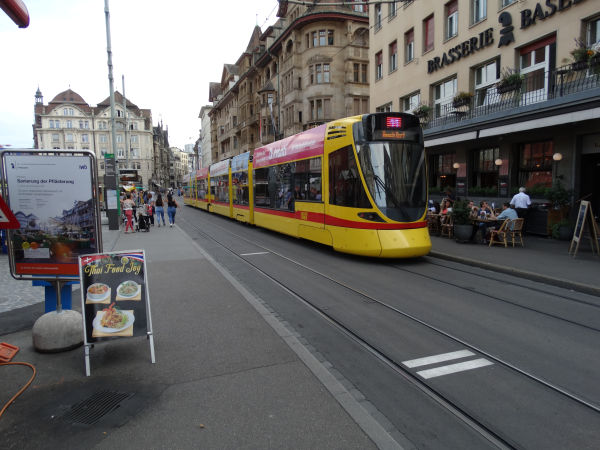
The same Stadler Tango tram Be 6/10 no.183 as shown above, but seen here from behind. With 45 metres it is a remarkably long tram.
Picture from Marktplatz tramstop in Basel 12.7.2019 by Ilkka Siissalo.
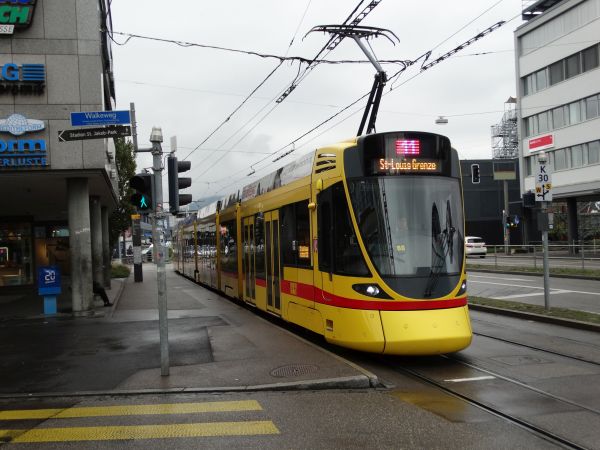
Yet another Stadler Tango tram Be 6/10 stopping at the tramstop Dreispitz on the line 11.
Picture 5.11.2022 by Ilkka Siissalo.
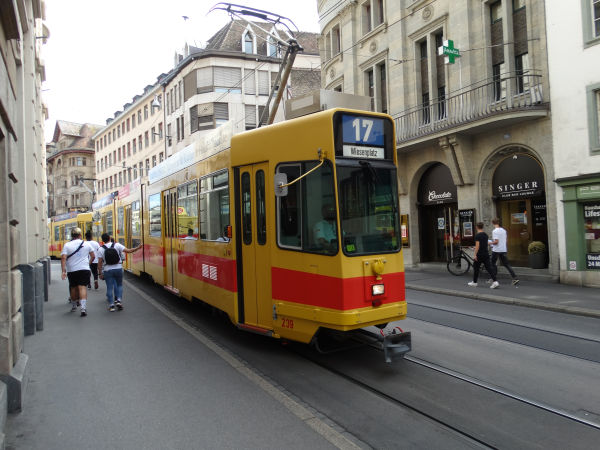
These trams were built by Schindler Waggon AG in Pratteln 1978-81 and some of them like for example this one no.239
were elongated 1986-1999 by adding an extra low-floor section in the middle of the tram. Here we see a long train which consists
of one elongated and one non-elongated Schindler wagon.
Picture from Marktgasse near Marktplatz in Basel 12.7.2019 by Ilkka Siissalo.
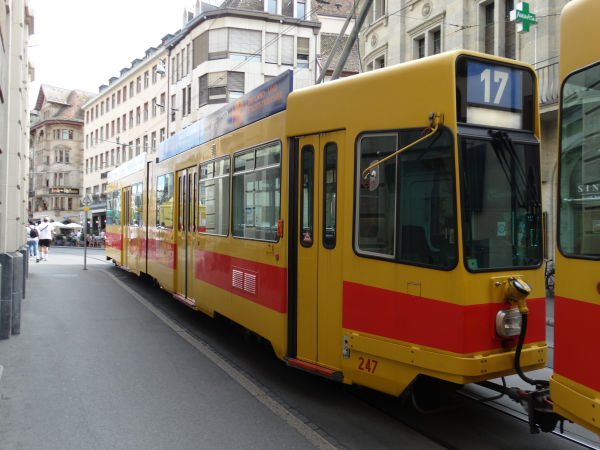
This Schindler tram Be 4/6 no.247 was never elongated with a low-floor piece and it was mainly used as a trailer.
Picture from Marktgasse near Marktplatz in Basel 12.7.2019 by Ilkka Siissalo.
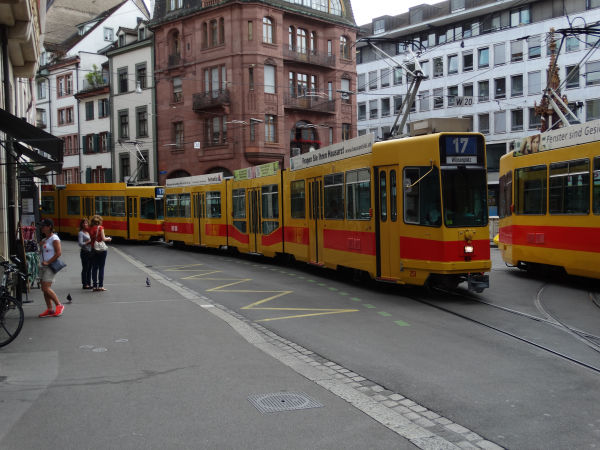
A similar composition like the one shown above, here we have a combination of one elongated Schindler tram of the type Be 4/8 plus
one non-elongated of the type Be 4/6 here on line 17 by the tram stop Schifflände. This type of combinations were the standard
BLT trams around the year 2000 on BLT's main tram lines 10 and 11, but nowadays they are only seen on the rush-hour additional
line 17. New Stadler Tango trams have replaced them on the main lines.
Picture by Schifflände in Basel 12.7.2019 by Ilkka Siissalo.
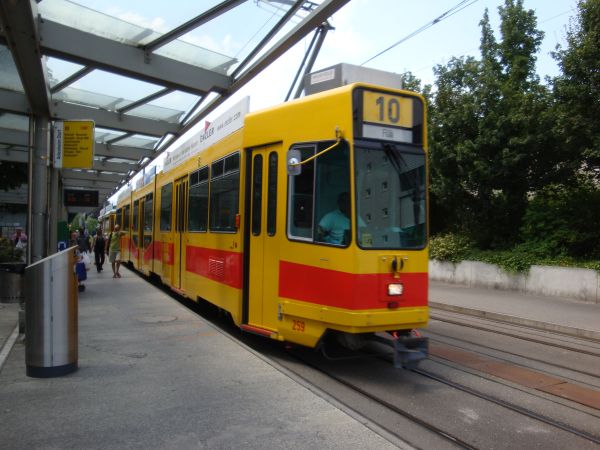
Here we see a composition that was very typical for the BLT line 10 at least during the years 1995-2010. The wagon in the front
is an elongated Be 4/8 with a later added low-floor middle part. The wagon used as a trailer is one of the 100 series Be 4/6 wagons
which were new during the 1970s.
Picture from the tramstop Arlesheim Dorf 10.7.2010 by Ilkka Siissalo.
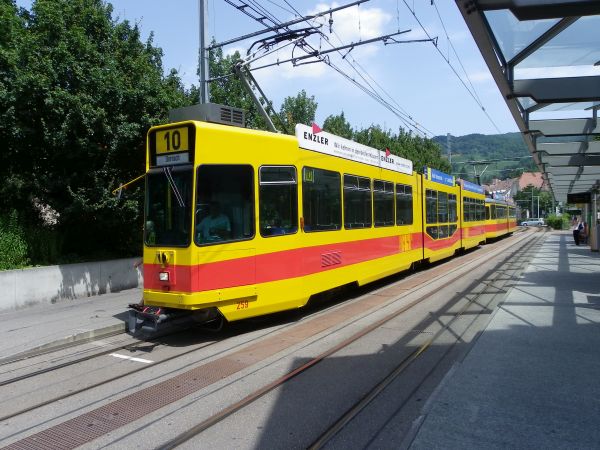
This picture was taken only minutes after the one shown above. An exactly similar Be 4/8 + Be 4/6 combination is here arriving
at the tramstop Arlesheim Dorf. But this tram composition is now arriving from the direction of Basel city, whereas the tram in the
picture shown above was heading there.
Picture from the tramstop Arlesheim Dorf 10.7.2010 by Ilkka Siissalo.
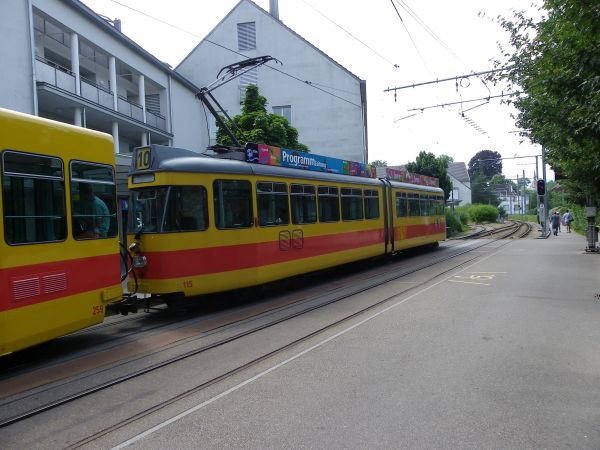
This is the same tram composition that was already shown in the picture above, but now we see the trailer wagon Be 4/6 of the 100
series a bit better. These trams were from the 1970s.
Picture from the tramstop Arlesheim Dorf 10.7.2010 by Ilkka Siissalo.
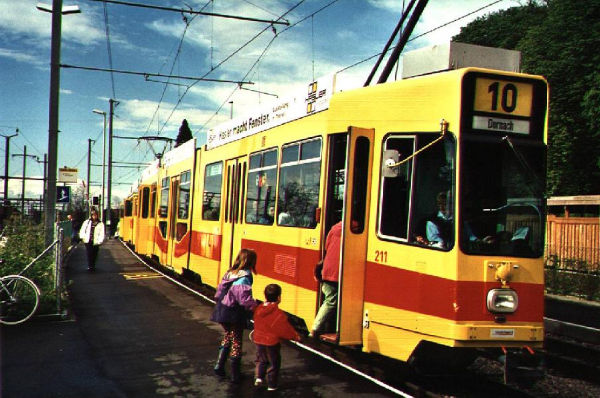
Partly low floor articulated tram Basellandtransport BLT no. 211 on its way to Dornach on line
10 at Elektra Birseck, Münchenstein, Kanton Baselland. As a trailer coach was an unidentified
100 series articulated tram. This was one of the longest combinations seen in Basel in that time. Line 10
takes over an hour to ride end to end, and the line runs on the terrains of three Swiss
Kantons (Basel Stadt, Baselland and Solothurn) and two countries. One stop is in France.
Photo May 1999 by Ilkka Siissalo.
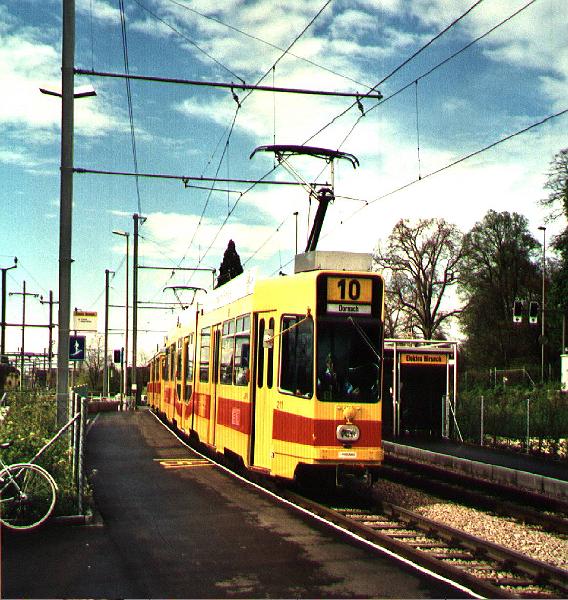
Baselland BLT 211 and unidentified tram of the 100 series as a combination on line 10,
halting to a stop at Elektra Birseck, Münchenstein.
Photo from May 1999 by Ilkka Siissalo.
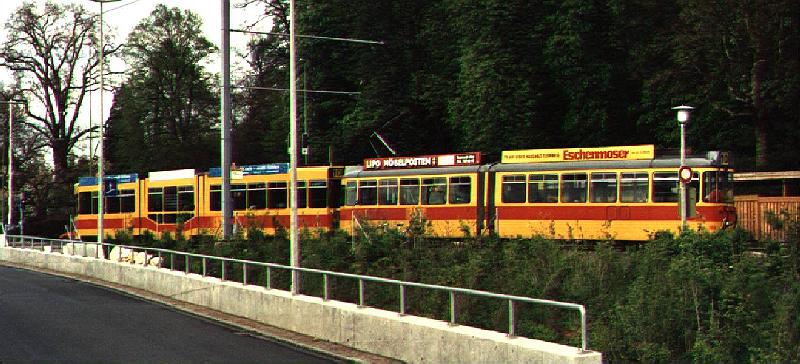
An unidentified Baselland BLT partly low floor tram of the 200 series, with a 1960´s 100
series tram 106 as a trailer wagon on line 10 in Münchenstein, Baselland. The picture is
taken from far away to show the remarkable length of a typical BLT tram combination.
Photo May 1999 by Ilkka Siissalo.

This is a Basel BVB Düwag Be 4/6 tram, which had been sold to the Baselland Kanton tram company BLT and repainted in BLT´s
yellow and red colours. When BVB started using its first brand new Siemens Combino trams in 2001 and 2002, many the
old Düwags were put out of service. Some were donated to ex-Yugoslavia, but some - like this one - were sold to the "neighbors",
the neighboring company Basellandtrafik BLT, operating on the same tracks. BLT replaced older trailers with the Düwags. The old
Düwag actually looks a lot better in its new painting. It is 19,735 m long, weighs 23 tons and has 40 places to sit and place for
113 standing passengers.
Photo from the tram stop St.Louis Grenze in Basel 21.6.2002 by Ilkka Siissalo.
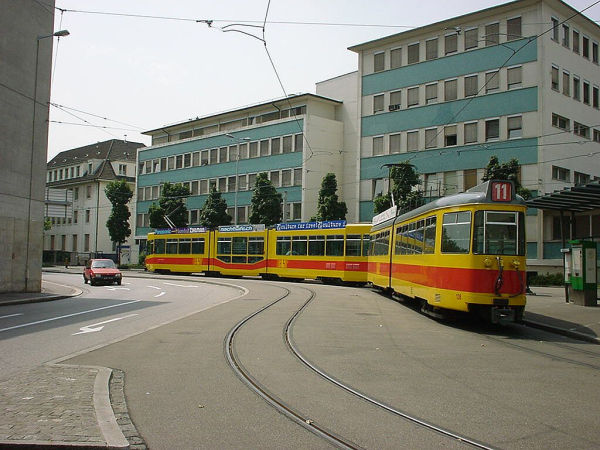
Another view of the extremely long combination at the line 11. "St Louis Grenze" end station by the French Alsace border
in Basel. First wagon is a Be 4/8 and the trailer is a Düwag Be 4/6. The first wagon was originally built as Be 4/6 between 1978
and -81 by Siemens. BLT had 66 of these wagons. Many of them - like this one - were later retrofitted with an extra
middle part in the low floor style to become a Be 4/8 wagon, 26,2 meters long, but the lengthening was done nicely in the same
style, not spoiling the wagons as Basel BVB did. The trailer wagon, Düwag Be 4/6 was built some time between 1967 and -72
by German Düwag, Siemens and BBC. It is 19,7 meters long. It is a huge combination as a tram.
Photo from the tram stop St.Louis Grenze in Basel 21.6.2002 by Ilkka Siissalo.
Waldenburgerbahn WB
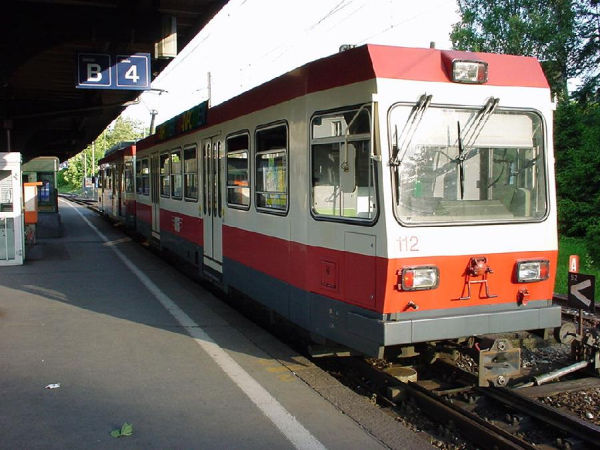
Switzerland is full of strange small private railroads. One of the smallest ones was WB or
Waldenburgerbahn, which operated a really narrow gauge railroad with only 750 mm rail track
gauge - the only one in the country with just a 75 cm gauge width. In 2021-22 the line was rebuilt
and regauged to 1 metre gauge and it is now a part of the BLT tram network as tram line no.19.
It runs from Liestal, the small capital town of Kanton Baselland, some 20 minutes, only 13 km,
uphill along a river valley, sometimes in full countryside environment, but also serving small suburban
style villages, ending at the village of Waldenburg. Waldenburgerbahn was opened for traffic in 1880.
It brought workers to work at the Liestal area factories and it also connected the small villages of
the river Frenke valley to the "real" railroad at Liestal station. Since 1985 WB had six modern two coach EMUs,
running on 1500V DC and on the 750 mm gauge. It looked like an odd crossing between a tram and a real train.
During 2019 it was announced that the two companies BLT and WB will be fusioned. The whole railways system of WB
was regauged from 750 mm to metre gauge and WB's trains were replaced by new trams painted in the yellow and
red colours of BLT.
Photo of WB BDe 4/4 no. 12 with matching coach no. 112 at Liestal station, 4th June 1999 by Ilkka Siissalo.
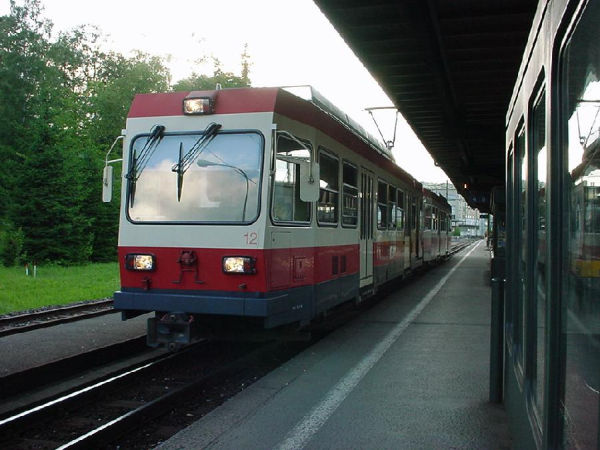
Waldenburgerbahn BDe 4/4 no. 12 with matching coach no. 112 at Liestal station. WB bought
these trains, which look like a cross between trams and trains in 1985-86 and they had six
pairs of this kind in operation. The motor wagons could also be used alone, without the trailer,
since the motor wagon had a cockpit at both ends.
Photo from Liestal station 4th June 1999 by Ilkka Siissalo.
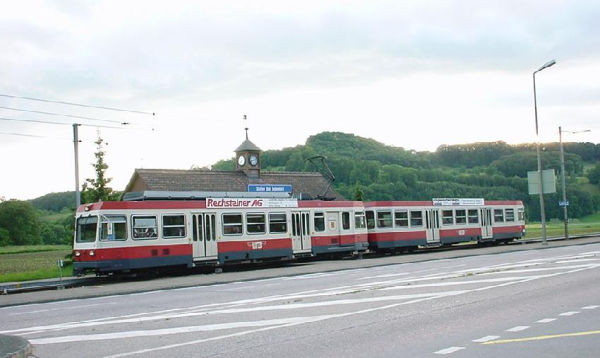
Waldenburgerbahn WB BDe 4/4 no. 14 with its trailer coach no. 114 stopping at the old Bad
Bubendorf station. Note the motor wagon´s special cargo department for transporting
cycles - many people continued with bike from Liestal station to their work.
The old station is also fascinating - unfortunately it is here behind the train - it even has
a water outlet to fill the tanks of the old steam engine that still used to run as long as the line was 750 mm gauge.
Photo from Bad Bubendorf 4th of June 1999 by Ilkka Siissalo.

There it goes. The Waldenburgerbahn BDe 4/4 was much like a tram and had actually been built
with many components from trams of the Swiss "Tram 2000" design concept.
Photo from Bad Bubendorf 4th of June 1999 by Ilkka Siissalo.

These were the previous trains of Waldenburgerbahn before the BDe 4/4 models shown above. This one was also called BDe 4/4 (earlier BFe 4/4) but
these trains were from the year 1953 and they were taken out of use when the ones shown above emerged in 1985.
Picture of a Waldenburgerbahn WB train BDe 4/4 no.3 from the year 1953, built by Schindler Waggons. The picture was taken by Alain Gavillet in 1975
and it has been published under the Creative Commons
CC BY 2.0 license
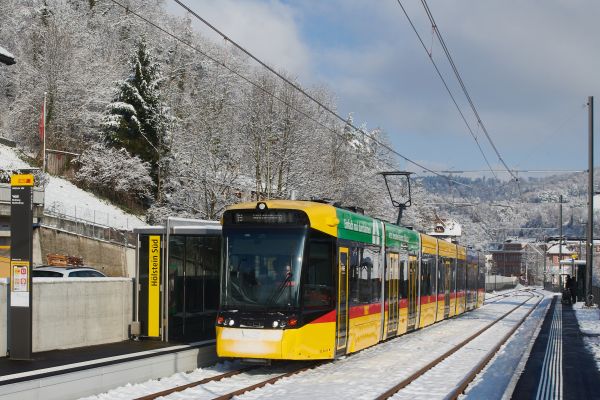
These are now the new tram-trains running from 2022 onwards on the Waldenburgerbahn. As already mentioned above, the whole railroad was totally rebuilt
and regauged to 1000 mm gauge. These new trams were designed by the company Vossloh-Kiepe and after Stadler bought Vossloh's train production they are
now called Stadler Tramlink. The Waldenburgerbahn train route has also been renamed to Basel tramline no.19 from Liestal to Waldenburg,
Picture 1.1.2022 during test runs from the tram stop Hölstein Süd by Wikimedia user MBxd1. Picture has been published under the Creative Commons
CC BY-SA 4.0 license.
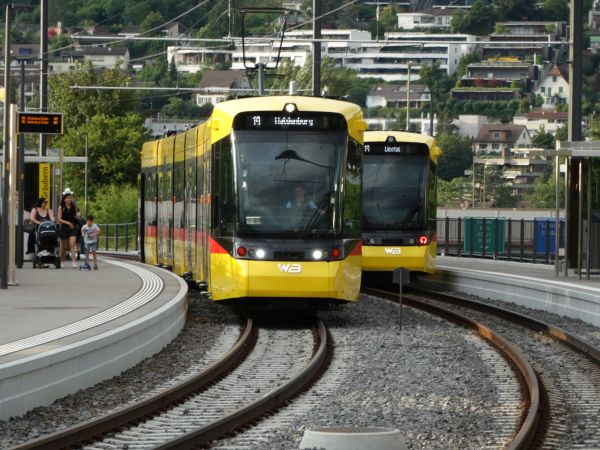
Two new Tramlink trams meeting at the tramstop Gräubern on the Waldenburgerbahn route.
Picture from Gräubern near Liestal station 12.7.2023 by Ilkka Siissalo.
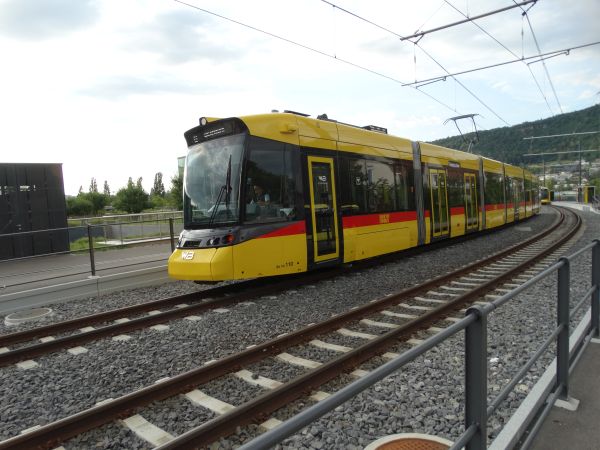
Two new Tramlink trams are really long. They have driver's cabs at both ends and doors on both sides.
Picture from Gräubern near Liestal station 12.7.2023 by Ilkka Siissalo.
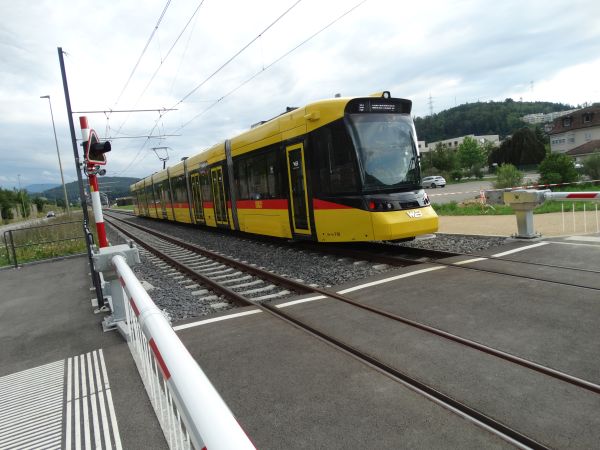
The same Tramlink tram as hown above, but now seen from the other direction.
Picture from Gräubern near Liestal station 12.7.2023 by Ilkka Siissalo.

